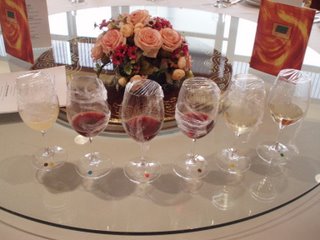
I have enjoyed thoroughly speaking in my recent wine event in Hong Kong. I have a wonderfully inquisitive audience and great companionship. We tasted altogether 8 wine labels, each with its own unique palate. The wines were selected to match with the food and its cooking style. As we know that Asian cuisine uses a large variety of herbs and spices, in addition to sauces made from dried plants or preserved meat, it is sometimes difficult to tell apart the quality of meat from the sauces used. With this in mind, I specially requested the chef to modify two of his dishes to accommodate a ‘minimum interference’ cooking style that I miss so much in restaurants these days.
It is a 10 course seafood dinner, cooked in the traditional Cantonese style that uses a fair bit of reduced meat soup to enhance the umami of the dishes. The rule of pairing utilizes two basic principles – a) to complement and b) to contrast.
Chinese culture is all about achieving a harmonious balance and it is most decorated in the use of ingredients in many Chinese cuisines. Wine can be considered an ingredient or a dish companion. In both cases, the objective is to achieve a balance in the palate. While most of the food and wine pairing focuses on using wines from different regions to be paired with a selection of dishes, I decided to introduce my favourite wine into both the food and as a pairing companion. Below is the highlights of the pairing given the limited space in this blog.
Sherry and Pan-fried Scallops
Sherry is my all time favourite aperitif and apart from drinking, Sherry is also versatile enough to be included in cooking. There are many recipes involving Sherry but the one I like best is to use a dry Sherry in pan-fried fresh scallops, sautéed with butter, salt and pepper. This is a simple and yet delicious dish that never fails to impress. The complementary wine is none other than the Fino Sherry which is dry with balanced acidity. The yeasty nose blends well with the flavour of the food.
Chablis and Braised Shark Fins SoupA well aged Chablis Grand Cru has a complex aroma, sometimes smoky and has a long, mouth-watering finish. However, young Chablis may express the mineral and acidic aromas more explicitly and this is reflected in the Chablis we drink during the dinner - Grand Cru "Bougros" from William Fevre 2004, The wine has a very pleasant pale, green-tinged hue that immediately suggests vitality. The nose is mineral and clean, flavour is fresh, sappy with balanced acidity and a great savoury feel in the month. The finishing is of medium length and is very pleasant. The level of acidity is just perfect for the Shark Fins soup, giving the palate a refresh taste by cutting through the texture of the shark fins and its braised sauce. This is a good example of a contrast pairing.
Sauvignon Blanc and Steamed FishCloudy Bay has put New Zealand onto the wine map with its Sauvignon Blanc. The Hong Kong style steamed fish uses soya sauce (diluted with some sugar), ginger and spring onions. There is sufficient umami in the dish and I am willing to use this fruity Sauvignon Blanc to match with it. Voila! The combination is magical as the tropical, less acidic wine brings out the freshness of the fish in a complementary manner.
Bordeaux and Braised Abalone
The emergence of second growths and second labels in Bordeaux are capable of challenging the First Growths in quality. Chateau Lascombes is a good example of a great Second Growth in the Margaux region. Although Lascombes is on the left bank, it deviates from the usual Bordeaux blend in terms of the grape variety apportionment. It uses a blend of 55% Merlot, 40% Cabernet Sauvignon, and 5% Petit Verdot. The higher proportion of Merlot soften the palate of this wine, giving it a smooth texture. The nose is the usual black berries and cassis but the tannin is smooth and almost sweet. It is a medium bodied wine that is easy to match with almost any food. The braised abalone is very well prepared, soft on the inside and smooth on the outside. The wine simply integrates into the food seamlessly, bringing out the sweetness of the abalone.
Auslese and Birds NestI have chosen an Auslese wine to pair with the Chilled sago cream and Birds Nest egg tart to ensure that the wine is just slightly sweeter than the desserts but not overpowering it. Selbach-Oster Riesling Auslese Zetling Schlossberg 2005 was selected for its youthfulness, a tribute to the daughter of our host. It has abundant fruit aromas, probably apple and citrus fruits. The palate is lightly oily, reminds me of honey and caramel. There is a tiny hint of bittersweet at the back palate which makes it a complex wine. The finishing is long and elegant. Traditional Chinese desserts are medium sweet and it is important that the wines we select will do justice to the combined palate. I was a little hesitant when I first know that we will have chilled sago with mango and pomelo as the latter contributes a bitter taste to the combination and if the wine is of lesser quality, the bitterness in the dessert will bring out the flatness in the dessert wine. Fortunately, the wine stands the test with its complex palate and has been a perfect companion thus far.
Overall, the food and wine pairing revolves around the theme of complementary principles mirroring the works of great Chinese philosophers. It is with complementary strengths that the result turns out to be better than consuming the food and wine separately. As with most episodes in life, this is a good chapter in our long journey of gourmet exploration.
Copyright of Wine Treasures Pte(S) Ltd
By Cher Lim
Wine Treasures Pte Ltd
Website:
http://www.wine-treaures.com/Email:
cher.lim@wine-treasures.comLabels: Food and Wine Pairing

